All Exams >
Class 7 >
Science Olympiad Class 7 >
All Questions
All questions of Motion and Time for Class 7 Exam
If a body moves in a circle, it starts from point A and after completing the circle comes back to A; the displacement of such body is- a)equal to the diameter of circle
- b)equal to the circumference of circle
- c)zero
- d)none of these
Correct answer is option 'C'. Can you explain this answer?
If a body moves in a circle, it starts from point A and after completing the circle comes back to A; the displacement of such body is
a)
equal to the diameter of circle
b)
equal to the circumference of circle
c)
zero
d)
none of these
|
|
Abhishek Pandey answered |
Circumference of circle
Which of the following is not in uniform motion?
- a)A fan's blade moving at a constant speed
- b)the rotation of earth
- c)a bullet travelling with a constant speed in a straight line.
- d)a swinging pendulum
Correct answer is option 'D'. Can you explain this answer?
Which of the following is not in uniform motion?
a)
A fan's blade moving at a constant speed
b)
the rotation of earth
c)
a bullet travelling with a constant speed in a straight line.
d)
a swinging pendulum
|
|
Abhiram Singh answered |
**Answer:**
The correct answer is option D, both (a) and (b).
**Explanation:**
Uniform motion is the type of motion in which an object covers equal distances in equal intervals of time. In other words, the object moves at a constant speed in a straight line. Let's analyze each option to determine if it represents uniform motion or not:
a) A swinging pendulum:
A swinging pendulum does not represent uniform motion because its speed is not constant. A pendulum swings back and forth, and its speed changes at each point in its swing. The speed is maximum at the lowest point (the equilibrium position) and decreases as it moves upward. Therefore, a swinging pendulum is not an example of uniform motion.
b) The rotation of the Earth:
The rotation of the Earth does not represent uniform motion because the Earth is not moving at a constant speed in a straight line. The Earth rotates on its axis, completing one rotation in approximately 24 hours. However, the speed of rotation is not constant. The Earth moves faster at the equator and slower at the poles. Therefore, the rotation of the Earth is not an example of uniform motion.
c) A bullet traveling with a constant speed in a straight line:
A bullet traveling with a constant speed in a straight line represents uniform motion. If a bullet is traveling at a constant speed, covering equal distances in equal intervals of time, it is an example of uniform motion.
Therefore, options a and b are not in uniform motion, while option c represents uniform motion. Hence, the correct answer is option D, both (a) and (b).
The correct answer is option D, both (a) and (b).
**Explanation:**
Uniform motion is the type of motion in which an object covers equal distances in equal intervals of time. In other words, the object moves at a constant speed in a straight line. Let's analyze each option to determine if it represents uniform motion or not:
a) A swinging pendulum:
A swinging pendulum does not represent uniform motion because its speed is not constant. A pendulum swings back and forth, and its speed changes at each point in its swing. The speed is maximum at the lowest point (the equilibrium position) and decreases as it moves upward. Therefore, a swinging pendulum is not an example of uniform motion.
b) The rotation of the Earth:
The rotation of the Earth does not represent uniform motion because the Earth is not moving at a constant speed in a straight line. The Earth rotates on its axis, completing one rotation in approximately 24 hours. However, the speed of rotation is not constant. The Earth moves faster at the equator and slower at the poles. Therefore, the rotation of the Earth is not an example of uniform motion.
c) A bullet traveling with a constant speed in a straight line:
A bullet traveling with a constant speed in a straight line represents uniform motion. If a bullet is traveling at a constant speed, covering equal distances in equal intervals of time, it is an example of uniform motion.
Therefore, options a and b are not in uniform motion, while option c represents uniform motion. Hence, the correct answer is option D, both (a) and (b).
Which of the following graphs does not represent constant speed? - a)

- b)
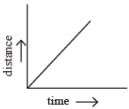
- c)
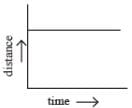
- d)
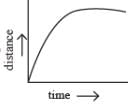
Correct answer is option 'D'. Can you explain this answer?
Which of the following graphs does not represent constant speed?
a)

b)

c)

d)

|
|
Lalith Togalla answered |
The answer is D. The answer is that because all are in a straight line on the graph except the last one because it is slanting. Also constant speed does not accelerate or decelerate on the graph but goes in the same speed for the whole time.
please upvote to me and my answer!!!!!
please upvote to me and my answer!!!!!
All of the following are units time except.- a)years
- b)light years
- c)seconds
- d)months
Correct answer is option 'B'. Can you explain this answer?
All of the following are units time except.
a)
years
b)
light years
c)
seconds
d)
months
|
|
Geetika Shah answered |
A light year is the distance covered by light in one year, so it is the unit of distance and not of time.
A jet is moving with a speed of 180 km/h. What is its speed in m/s?- a)50 m/s
- b)10 m/s
- c)500 m/s
- d)100 m/s
Correct answer is option 'A'. Can you explain this answer?
A jet is moving with a speed of 180 km/h. What is its speed in m/s?
a)
50 m/s
b)
10 m/s
c)
500 m/s
d)
100 m/s
|
|
Sharada patil answered |
Understanding Speed Conversion
To convert speed from kilometers per hour (km/h) to meters per second (m/s), we need to understand the relationship between these two units.
Conversion Factor
- 1 kilometer = 1000 meters
- 1 hour = 3600 seconds
Therefore, to convert km/h to m/s, we can use the following formula:
Conversion Formula
- Speed in m/s = Speed in km/h × (1000 meters / 1 kilometer) × (1 hour / 3600 seconds)
This simplifies to:
- Speed in m/s = Speed in km/h × (1000 / 3600)
Performing the Calculation
Now, let's convert 180 km/h to m/s:
- Speed in m/s = 180 km/h × (1000 / 3600)
Calculating this:
- Speed in m/s = 180 × (1000 / 3600)
- Speed in m/s = 180 × (1 / 3.6)
- Speed in m/s = 180 / 3.6
- Speed in m/s = 50 m/s
Conclusion
Thus, the speed of the jet moving at 180 km/h is equivalent to 50 m/s.
The correct answer is:
Option A: 50 m/s
To convert speed from kilometers per hour (km/h) to meters per second (m/s), we need to understand the relationship between these two units.
Conversion Factor
- 1 kilometer = 1000 meters
- 1 hour = 3600 seconds
Therefore, to convert km/h to m/s, we can use the following formula:
Conversion Formula
- Speed in m/s = Speed in km/h × (1000 meters / 1 kilometer) × (1 hour / 3600 seconds)
This simplifies to:
- Speed in m/s = Speed in km/h × (1000 / 3600)
Performing the Calculation
Now, let's convert 180 km/h to m/s:
- Speed in m/s = 180 km/h × (1000 / 3600)
Calculating this:
- Speed in m/s = 180 × (1000 / 3600)
- Speed in m/s = 180 × (1 / 3.6)
- Speed in m/s = 180 / 3.6
- Speed in m/s = 50 m/s
Conclusion
Thus, the speed of the jet moving at 180 km/h is equivalent to 50 m/s.
The correct answer is:
Option A: 50 m/s
Distance travelled will be equal to the displacement if- a)object is moving along straight line in forward direction.
- b)object is moving in different directions.
- c)object is moving from one point to other along any path
- d)not possible in any condition.
Correct answer is option 'A'. Can you explain this answer?
Distance travelled will be equal to the displacement if
a)
object is moving along straight line in forward direction.
b)
object is moving in different directions.
c)
object is moving from one point to other along any path
d)
not possible in any condition.
|
|
Rohini dubey answered |
Understanding Distance and Displacement
Distance and displacement are fundamental concepts in physics that describe the movement of an object.
Distance
- It refers to the total path length traveled by an object, regardless of its direction.
- It is a scalar quantity, meaning it only has magnitude and no direction.
Displacement
- Displacement is the shortest distance from the initial to the final position of an object, along with the direction.
- It is a vector quantity, which means it has both magnitude and direction.
When Do Distance and Displacement Equal Each Other?
- The distance traveled is equal to the displacement when the object moves in a straight line without changing direction.
- In such cases, the path taken by the object is a straight line from the starting point to the endpoint.
Why Option A is Correct
- Straight Line Movement: If an object moves in a straight line in a forward direction, the distance it covers and the straight-line distance from the starting point to the endpoint are identical.
- No Changes in Direction: Since there are no changes in direction, the total path length equals the direct distance between the two points.
Other Options Explained
- Option B: If the object is moving in different directions, the distance will be greater than the displacement.
- Option C: Movement along any path, especially if it's not straight, will result in a larger distance than displacement.
- Option D: It is indeed possible for distance to equal displacement under specific conditions, such as straight-line movement.
In conclusion, option A is the correct answer because it accurately describes the condition under which distance and displacement are equal.
Distance and displacement are fundamental concepts in physics that describe the movement of an object.
Distance
- It refers to the total path length traveled by an object, regardless of its direction.
- It is a scalar quantity, meaning it only has magnitude and no direction.
Displacement
- Displacement is the shortest distance from the initial to the final position of an object, along with the direction.
- It is a vector quantity, which means it has both magnitude and direction.
When Do Distance and Displacement Equal Each Other?
- The distance traveled is equal to the displacement when the object moves in a straight line without changing direction.
- In such cases, the path taken by the object is a straight line from the starting point to the endpoint.
Why Option A is Correct
- Straight Line Movement: If an object moves in a straight line in a forward direction, the distance it covers and the straight-line distance from the starting point to the endpoint are identical.
- No Changes in Direction: Since there are no changes in direction, the total path length equals the direct distance between the two points.
Other Options Explained
- Option B: If the object is moving in different directions, the distance will be greater than the displacement.
- Option C: Movement along any path, especially if it's not straight, will result in a larger distance than displacement.
- Option D: It is indeed possible for distance to equal displacement under specific conditions, such as straight-line movement.
In conclusion, option A is the correct answer because it accurately describes the condition under which distance and displacement are equal.
Study the graph given below. How is the speed of the moving body?

- a)It goes on increasing
- b)First it is constant and then becomes zero
- c)It increases and then becomes constant but not zero
- d)It decreases and then becomes constant but not zero
Correct answer is option 'C'. Can you explain this answer?
Study the graph given below. How is the speed of the moving body?


a)
It goes on increasing
b)
First it is constant and then becomes zero
c)
It increases and then becomes constant but not zero
d)
It decreases and then becomes constant but not zero

|
Nayanika Chauhan answered |
Speed is the change of position of the body with respect to time. From the graph It increases and then becomes constant but not zero
The following graph shows the motion of four runners. P, Q, R and S in a 5 km marathon. Whose motion is the fastest?
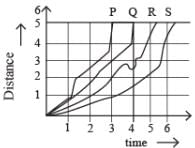
- a)P
- b)Q
- c)R
- d)S
Correct answer is option 'A'. Can you explain this answer?
The following graph shows the motion of four runners. P, Q, R and S in a 5 km marathon. Whose motion is the fastest?


a)
P
b)
Q
c)
R
d)
S
|
|
Sharmila Dey answered |
The time taken by P is the lowest among the four, because more is the area under the wine, greater is the speed. Hence, P is the fastest.
The area of the shaded portion in the graph shown below represents?
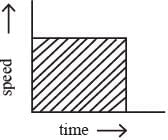
- a)distance
- b)speed
- c)time
- d)none of these
Correct answer is option 'A'. Can you explain this answer?
The area of the shaded portion in the graph shown below represents?


a)
distance
b)
speed
c)
time
d)
none of these

|
Kairvi Yadav answered |
Distance because time and speed is already there but if we think speed and time it is distance.
([A] DISTANCE)
([A] DISTANCE)
Which of the following is the fastest?- a)wind
- b)light
- c)sound
- d)cheetah
Correct answer is option 'B'. Can you explain this answer?
Which of the following is the fastest?
a)
wind
b)
light
c)
sound
d)
cheetah
|
|
Anushka Shah answered |
A fan shows circular motion.
One mean solar day is equal to how many seconds?- a)80, 406
- b)80, 640
- c)86, 400
- d)84, 600
Correct answer is option 'C'. Can you explain this answer?
One mean solar day is equal to how many seconds?
a)
80, 406
b)
80, 640
c)
86, 400
d)
84, 600
|
|
Jyoti Kulkarni answered |
Mean solar day = 24 h
= 24 × 60 × 60
= 86400 seconds
= 24 × 60 × 60
= 86400 seconds
The CGS unit of speed is- a)cm/g
- b)cm/s
- c)m/s
- d)m/g
Correct answer is option 'B'. Can you explain this answer?
The CGS unit of speed is
a)
cm/g
b)
cm/s
c)
m/s
d)
m/g
|
|
Saptarshi Jain answered |
The CGS unit of speed is cm/s.
Chapter doubts & questions for Motion and Time - Science Olympiad Class 7 2025 is part of Class 7 exam preparation. The chapters have been prepared according to the Class 7 exam syllabus. The Chapter doubts & questions, notes, tests & MCQs are made for Class 7 2025 Exam. Find important definitions, questions, notes, meanings, examples, exercises, MCQs and online tests here.
Chapter doubts & questions of Motion and Time - Science Olympiad Class 7 in English & Hindi are available as part of Class 7 exam.
Download more important topics, notes, lectures and mock test series for Class 7 Exam by signing up for free.
Science Olympiad Class 7
33 videos|106 docs|54 tests
|
Signup to see your scores go up within 7 days!
Study with 1000+ FREE Docs, Videos & Tests
10M+ students study on EduRev

Contact Support
Our team is online on weekdays between 10 AM - 7 PM
Typical reply within 3 hours
|
Free Exam Preparation
at your Fingertips!
Access Free Study Material - Test Series, Structured Courses, Free Videos & Study Notes and Prepare for Your Exam With Ease

 Join the 10M+ students on EduRev
Join the 10M+ students on EduRev
|

|
Forgot Password
OR
Signup to see your scores
go up
within 7 days!
within 7 days!
Takes less than 10 seconds to signup












